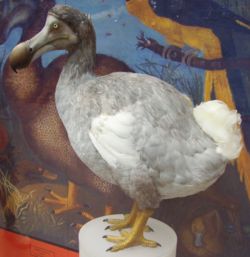|
The Dodo bird once lived on the island of Mauritius which is off the coast of Africa
The Dodo bird once lived on the island of Mauritius which is off the coast of Africa. It was a flightless bird and was related to the pigeon and the dove. It built its nest on the ground due to the it's inability to fly. Thus it made the eggs easy to be trampled upon and to be preyed upon by other animals that were introduced by the Portuguees From various records, pictures and the few fossils of the bird that remain, ornithologists and scientists have put together a rather detailed description of the dodo bird. It was a large, fairly plump bird that was covered in soft, grey feathers. It had a plume of white feathers at its tail. The dodo had very small wings that were much too small and too weak to even lift this bird off the ground. Those who actually saw this bird thought that it had no real wings but “little winglets”. However, after the skeleton was studied, it was found that this bird did in fact have wings. They were similar to penguins wings seeing that penguins do not really fly either. The dodo bird had short, stubby legs that were yellow in color. The dodo had four toes, three in the front and one that acted like a thumb in the back. They all had thick, black claws. The head of the dodo was a lighter color grey than the rest of the body and it had small, yellow eyes. One of the most distinguishing characteristics of the dodo bird was its long, hooked and crooked beak. It was a pale yellow or light green in color. Those who saw this bird marveled at its unique size and shape. One witness who saw the dodo described it as being grotesque. It was thought that the diet of the dodo bird consisted mainly of fruit. Some people who visited Mauritius marveled at the fact that they saw the dodos eating iron and stones with no trouble at all. It is now believed that the rocks eased the dodo’s digestion. Not much is known about the mating and incubation periods of the dodo. It was described by several people that the dodo made its nest deep in the forest in a grassy bed. The female would lay one single egg which she protected and raised. Having reached the island of Mauritius, the dodo bird began to adapt over the next several million years to being on an island that had virtually no predators and a great wealth of fruit that lay on the ground. The dodo began to trade its ability to fly for the ability of being able to store greater amount of fat that would be able to carry this bird through the scarce times when food was not so plentiful. This consequently made the dodo bigger and made it much more difficult to fly. This was an easy choice for the dodo to make as there were no enemies on this island for them to flee from. At around the year of 1505 the Portuguese were the first to discover the dodo. These birds were trusting and friendly and really had no reason to fear man. That made them easy targets. They would not try to run and hide from the sailors and they hardly even bothered to get out of the sailors’ way. By 1681, the dodo was driven to extinction by man, pigs, monkeys, feral dogs, and rats that were all introduced by the Europeans to Mauritius. These animals heralded the death blow to the species as they preyed upon the dodo’s eggs and chicks as well as the adults. Although this unusual bird suffered extinction in 1681, the story does not stop here. The effects of an extinction of a species are just beginning to be understood. A scientist recently notices that a certain type of tree on Mauritius was becoming quite rare. He noticed that of all of the 13 trees of the species that remained were approximately 300 years old. There had been no trees that had germinated since the later part of the 1600’s. It was found that this type of tree lived to be about 300 years old. That meant the very last of these trees were very old, they were soon to die and then the species would become extinct. It seems awfully coincidental that this tree had stopped reproducing about 300 years ago just about the time that the dodo bird became extinct. After doing some more research, it was found that the dodo’s diet consisted of the fruit that this tree produced. The seeds of this tree could only become active and grow after they passed through the dodo’s digestive system. Therefore this tree’s extinction had a direct bearing on the dodo’s extinction
|

